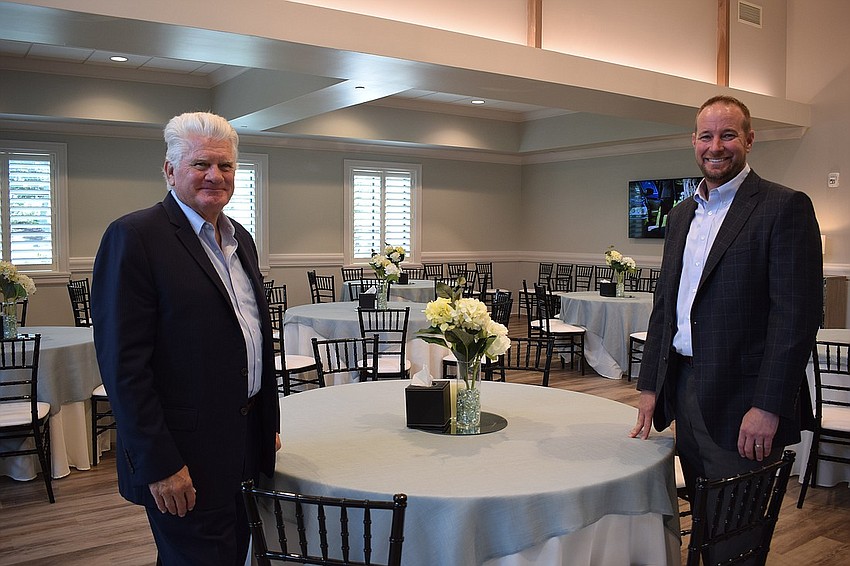- April 7, 2025
-
-
Loading

Loading

For an industry as old as dying, the funeral sector hasn’t changed much.
Jeff Toale is one of several longtime funeral home executives in the region seeking to alter that. While the shifts he and his company have made are substantial, Toale is motivated by a simple measuring stick. “We want to change the conversation in the car after the service,” he says.
Toale is driving that change through the Robert Toale & Sons Celebration of Life Center, a Sarasota-based funeral and cremation services company under the Dignity Memorial brand. Working with his father Robert, mother Debbie and brother Jason, Jeff Toale oversees the 6,700-square-foot Celebration of Life Center in Lakewood Ranch. That center, on 4310 Solutions Lane, near a gymnastics center, LECOM School of Dental Medicine and the Central Park at Lakewood Ranch housing community, opened in May 2022. “It was a big investment,” Toale says of the project, which, with the land purchase and construction, cost over $1 million.
The Toales also recently turned a funeral home they own on Tamiami Trail in south Sarasota, the former Wiegand Brothers Funeral Home, into a Celebration of Life Center. The idea at both locations is to deliver a new way for people to honor loved ones who have died. A few others in the industry have tinkered with new models like this in recent years, going back to just before the pandemic, but big changes, says Toale, have come slowly. “People don’t want a traditional funeral anymore,” Toale says. “But funeral directors can be a stubborn group.”
Utilizing this new model is one reason the Toales split from Toale Brothers Funeral Home, another Sarasota-based family business, in 2018. Jeff Toale and his brother and parents’ operation joined Dignity Memorial — the flagship funeral, cremation and burial services brand of Houston-based Service Corporation International. SCI is an industry giant that posted $4.1 billion in revenue in 2022.

Now, about 18 months into the shift in model to focus more on celebrations of life, Jeff Toale says interest, and business, has been brisk. His biggest challenge, he says, is customer education, that, for a lack of a better term, this isn’t your grandmother’s funeral. In addition, the Toale Celebration of Life centers are open for other events.
“My job is really to get people in the building,” says Toale, a third-generation funeral director. “I’m smart enough to know once they get in, the building speaks for itself.”
Those building features include higher ceilings and more natural light and wood floors to make it more airy and sunny, and not so dark and gloomy. The centers also feature round tables instead of pews, to make it easier for people to talk to one another about their recently deceased friend or relative. The centers even have catering capabilities. “We did a deep dive into what people wanted out of their celebrations,” Toale says.
“It was hard for everyone in the beginning to see what it would look like in the end,” he adds, “but once they got it, they really loved it.”
Funeral services industry executive Tony Kumming has seen a few other companies try to transition from staid funeral home to a celebration of life model. While not specifically tracking Jeff Toale and his family’s efforts, Kunming, based in St. Petersburg, says the key to making it work is if they can do it often and at multiple locations. “If so, people will try to replicate it,” says Kumming, president of St. Pete-based funeral home acquisition and management firm Pinnacle Funeral Service.
Pinnacle operates about 30 funeral homes in seven states. It’s one of a handful of companies, says Kumming, that manage a variety of funeral homes under various family names, using economies of scale and centralized services to grow. There are a few others, like SCI, that are publicly traded or rely on private equity to grow. After that, about 80% of the industry, Kunming estimates, are family-owned, mom and pop operations.
The industry is worth some $20 billion annually, according to US Funeral Online, an industry web portal geared toward consumers. There are about 2.4 million funerals a year — a figure that spiked significantly in 2020-2021, US Funeral Online reports, when there were some 3.4 million COVID-19 related deaths. There are about 23,000 funeral homes nationwide, according to data firm IBISWorld, though exact numbers are hard to pinpoint due to various state regulations.

The industry’s revenue growth-to-profit margin trajectory is something of a paradox. Industry revenue is up 0.9% in 2023, IBISWorld reports, and the compound annual growth rate since 2018 is 1.9%. Also, the volume of work is projected to continue to expand, particularly as the baby boomer population ages.
The flip side is as the cremation rate grows, funeral home profits are in decline. This is primarily because the cost of a funeral with a burial, on average, costs $1,000 more than a funeral with a cremation, according to data from the National Funeral Directors Association. The national cremation rate in 2023 is nearly two times greater than the burial rate, 60.5% to 34.5%.
Another study from the NFDA found the cremation rate is expected to increase in the United States from that 60.5% figure in 2023 to 81.4% by 2045. That report, the NFDA 2023 Consumer Preference Survey, found that 54.4% of respondents cited cost-effectiveness as the primary reason for choosing cremation, while 42.5% say cremation is easier, simpler, and more convenient.
Kunming says the industry faces other challenges that could squeeze margins.
Materials shortages and delays that have struck other sectors haven’t spared the funeral industry, for one. Ditto for inflation. One other issue is the increase in work during COVID-19 forced some in the funeral industry to get out sooner than maybe they would have otherwise. That’s caused an acute shortage of funeral home directors working in the industry. “The amount of people getting into the business,” Kunming says, “is not matching the amount of people leaving.”
Dignity Memorial, with some 1,900 funeral, cremation and cemetery service locations across North America, has been utilizing the celebration of life model at other locations in the region.
The Blount & Curry Life Event Center on MacDill Avenue in Tampa, for example, was renovated to include what’s now three spaces: the Bayshore Room, for more intimate and smaller gatherings; Palma Ceia Hall, a space for larger gatherings that, according to the funeral home’s website, features an “upscale hotel or country club” atmosphere; and Ybor 1929, a “speakeasy reminiscent of underground nightlife during the Prohibition era,” the company says.
Hodges Life Celebration Center in Bonita Springs, meanwhile, includes three flexible event spaces for up to 200 guests, designed with a light-filled foyer and expansive ceilings. A little bit south of that location, the Hodges Funeral Home at Naples Memorial Gardens includes not only floor to ceiling arched windows, but a unique wine room/wine cellar. “When you walk through the doors of our beautiful funeral home,” the Hodges website states, “we want you to feel like you’ve stepped into a fine Florida resort.”
Jeff Toale is happy to report those changes, and the ones his family have made in Sarasota and Lakewood Ranch, are beginning to pay off. One of the best compliments he gets, he says, and it happens regularly, is when “people come in, look at me and say ‘am I in the right place?’”